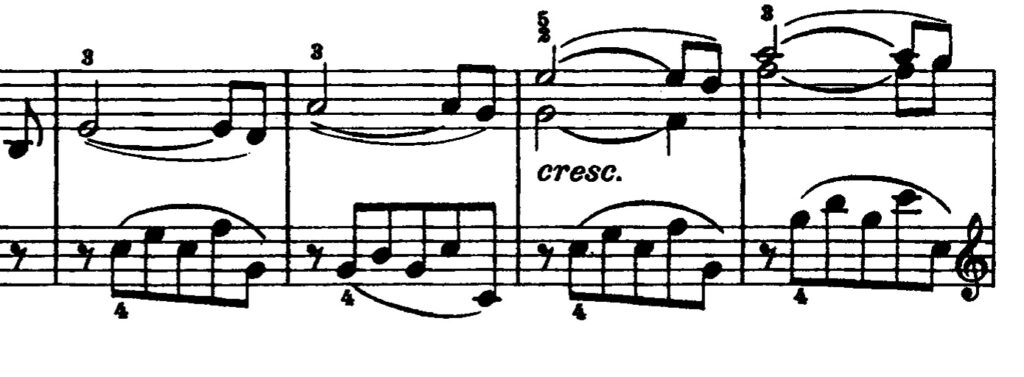Phrasing, the art of hearing it. Haydn, Sonata Eb I – hob. XVI:49.
For most piano students the phrasing markings in sheet music are yet another hurdle, often the last one. After weeks of practice to play the notes correctly. Because their teacher askes them to pay attention to it. A hurdle they sometimes don’t see the use of, the importance of. “ isn’t it ok the way I play it?” or “I like my version better”.
A common response from the teacher: “yes, you must do that, it’s the composer’s wish you do so.” Or more confronting: “isn’t your version just the way it plays most easily for you, not a thought out version?”. This way, it becomes an authority issue which most of the time doesn’t result in a more creative and satisfactory way of playing.
In my opinion in this situation both the student ánd the teacher miss the point!
To me the most important thing is: can you hear what the (written) phrasing does to the music?
So not forcing the student to play what’s written “because that’s what one should do”, but tempt and challenge: just try it, try it seriously, with attention. With an open mind and ears.
To train the skill of listening, focused listening, detailed listening. While you play. Which is not that easy at all. This way the composer’s phrasing can become a guide to playing and hearing the music in a way you might have never thought of yourself. Let the composer take you on a journey.

In the above fragment from a Haslinger sonatina there is a nice example of a rather unexpected phrasing. Would you have thought of this when there wouldn’t have been any slurs? I didn’t , Haslinger made this rather common progression sound really fresh to my ears and mind.
This way I acquired a new way of phrasing and added it to my inner toolbox of phrasings.
And that’s the whole point I think: to keep on listening and trying out other people’s phrasings, be it the composer’s or your favourite pianist’s. As to keep on building your own library of phrasing tools.
Eclecticism as a way to build your own musical language.
In my Haydn recording I selected from different editions the phrasings which were surprising, unexpected to me. Listen to the 16th notes in the start motive, 2 by 2, not 4 in a row.

And then even more unexpected and really nice: the last 8th note in the bar not being an upbeat to the next bar but the resolution of a suspension which occurred just barely an eight note before. So easy to miss this one….

As a pianist as well as pianoteacher I’m convinced that deepening your level of detailed playing and sharpening your ears, the issue which phrasing is the sole correct one disappears. It’s the level of your musical thinking and playing which becomes the satisfying part. You will be more inclined to play the composer’s phrasings. Or not. There is no longer a showdown between composer, teacher and student.
It’s the level of your ability to really hear what phrasing does, which counts. Which makes you choose (and practice) a musically valid and consistent option. The composer’s, the editor’s, your teacher’s or your own. Probably a mix of them :-).
Besides, we all know there are often more editions published of the same sheet music. With sometimes contradicting markings, also not clear which markings are the composer’s and which one the editor’s.
On top of that: even our most famous composers and artists are human beings just as we are, I don’t think they never changed their minds????. Just listen to Brendel who recorded the complete Beethoven sonatas three times during his career, an interesting way to study his inner musical development throughout the years.
PS
As to the the term phrasing: I’m using it in the broad sense of the word.
Not only legato slurs, creating longer lines or small motives as in the examples above, but also articultation marks like staccato or portato contribute to phrasing. Even the underlying rhythm can be used to structure the music, making some notes more important, other ones less.
The fact that we use not one but multiple means in phrasing the music does not affect the point I am trying to make in this blog, so I thought it best not to touch on this aspect.
Beautiful music, very good playing and interesting topic !
Welcome back Paul. Very interesting !
Een heel belangrijk onderwerp !! en vaak onderwerp van onze gesprekken tijdens de les. Dus super-herkenbaar. Zelf kort geleden nog de Haslinger sonatina gespeeld, en het is een wereld van verschil hoe de bogen/bindingen worden gespeeld. Enne … fijn dat er weer een Bechstein tapes editie is. Ik vind ze altijd leuk en leerzaam – ga zo voort, Paul !! (auto-translation) A very important topic !!! and often the subject of our conversations during class. So super-recognizable. I myself recently played the Haslinger sonatina, and it is a world of difference how the bows/bindings are played. Andne … nice that… Read more »
Interessante materie waar ik vroeger ( te) weinig mee had. nu ben ik daar scherper op en voegt het veel toe
(auto-translation) Interesting subject matter that I used to have ( too) little to do with. now I am keener on it and it adds a lot